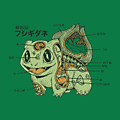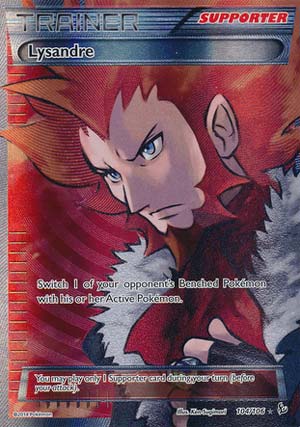Baby Mario
2010 UK
National
Seniors
Champion |
#4 Lysandre
The way the format has been for the past few years, we
need a card that has the effect which
Lysandre provides: namely
dragging a Pokémon up from the Bench to the active slot.
With cards like Garbodor
LTR, Blastoise BCR,
Dusknoir BCR out there, not
to mention punch-and-run attackers like
Donphan PLS hiding behind
Robo Substitute, we need a
way for decks to deal with them.
We did have Pokémon Catcher, of course, but many players
(not including me) thought it was too powerful, and when
it received an errata, it
became unreliable. Meanwhile, Bright Look
Ninetales and Flare Command
Pyroar are not something
that can just be splashed into any old deck. The
solution, printing Catcher in the form of a Supporter,
seems a reasonable one. Oh, and the fact that it
by-passes Item Lock shouldn’t be overlooked. With
Lysandre, any deck can now
make use of this powerful effect, but it must be used
with care as it takes up Supporter use for the turn. As
a result, running 1-2 copies has become standard
practice in just about every deck. With the recent
release of VS Seeker, Lysandre
has become an even more potent weapon as not only can it
be re-used, it can also be searched out when needed once
it hits the discard pile.
Lysandre
does an important job for a fair cost. Barring the
release of something less balanced, it should keep its
place in players’ decks until it rotates.
Rating
Modified: 4 (necessary)
Expanded: 4 (equally necessary)
|

aroramage |
Pokemon Catcher was a huge threat when it came out.
It was an Item with a simple effect, but as always the
simple effects made it highly playable and extremely
dangerous. In this case, it was a Switch on your
opponent's Pokemon, forcing them to bring out their
Bench-sitters for your big EX to crush underfoot. The
TCG guys errata'd this card's effect because of how
powerful it is, giving it a 50/50 shot of working, which
for an Item makes more sense.
Then Lysandre came and said, "Hey, remember when Pokemon
Catcher was cool? Well, I'll get you that effect as long
as I'm your Supporter for the turn." And the rest is
history.
Lysandre is a much more balanced Pokemon Catcher, but
it's still Pokemon Catcher in essence, meaning people
will run Lysandre for the same reason they ran Pokemon
Catcher. Should've just called him Lysandre the
Catcher-re, huh? No? Okay...
In any case, Lysandre being a Supporter just means
you've got to be more crafty when using him. He can help
you grab a crippled EX or snag a Bench-sitter to take
care of a nasty threat (hint hint Garbodor), so
naturally he's a powerful asset in an aggressive format.
Fighting decks run him, Fire decks run him, VirGen decks
run him, Blastoise decks run him, Metal decks run him,
Gengar decks run him - and let's face it, you probably
will run him too.
Rating
Standard: 5/5 (absolutely and undeniably useful, even at
the cost of a Supporter)
Expanded: 5/5 (I mean, can you not run him? Seriously,
is there a deck you wouldn't play Lysandre?)
Limited: 5/5 (of course you run him)
Arora Notealus: Something about being the leader of a
team of baddies must make it so you've gotta have an
awesome effect. Maxie and Archie placed Pokemon into
play immediately, Ghetsis profited off of Tools, even
Giovanni could bypass the rule of not evolving a Pokemon
you just played or evolved!
Next Time: And from the skies above...
|
|
Otaku |
Welcome to the conclusion of the second week of our Top 10 Cards Of
2014 Countdown! As we skipped both Christmas and the
day before (obvious reasons are obvious), maybe some
recapping will seem a little less gratuitous. The lists
were collected and averaged out from the CotD crew to
create the rankings for the master list. As with our
Top 10 lists for individual sets, reprints are excluded:
without this rule cards like Double Colorless Energy
place (if not place high) most years. For my own list,
my main guideline was card impact. I evaluated each
card according to breadth of impact (how widespread its
usage/response to its usage was), depth of impact (how
deeply it affected the decks that used it/needed to
counter it) and time of impact (how long did it affect
how we played in 2014).
Just missing out on a Top 3 finish, our fourth place finisher is
Lysandre (XY: Flashfire 90/106; 104/106).
You can read the original reviews for it
here;
as it was during my most recent hiatus, I didn’t get to
weigh in. I’d love to claim I knew it was going to be a
major factor in the game but I greatly underestimated
this card. So let’s cover some basics before discussing
how it has impacted the format.
Lysandre is a Supporter, meaning its got to have a great effect to justify
the fact that you can’t play the usual, strong draw or
search Supporter that decks in general have been built
since almost the introduction of Supporters. Even in
formats where you had strong Pokémon based search and/or
draw, the chief purpose of supporters was still draw
and/or search (yeah, sometime both, sometimes one or the
other) with the express purpose of getting your “real”
draw/search up and running. For the last five or so
years (and yes, that is an approximate because I don’t
remember exactly when the builds fully shifted over)
almost all noteworthy draw and search effects have been
Supporters, with the exceptions being Tropical Beach
and some more deck specific cards. Not getting a new
hand (even of a reduced size) or good search is a pretty
big cost, and a lot of otherwise good Supporters have
failed to see competitive play because of it.
I actually thought Lysandre would be underpowered at first.
Why? It is just a “Gust” effect. Gust effects are so
named (perhaps only by me) because Gust of Wind
is the oldest and perhaps best example of it and was
released in the Base Set and quickly became a
staple, with the exact count (at least two, upwards of
four, with three being pretty common) being in debate.
While other cards had a similar effect, the next
generic “normal Trainer” (re: Item) version was
Double Gust, so as a long time player, that is how
it still comes across, even though neither of those
cards have been Standard legal in over 10 years.
Continuing the history discussion, such effects have
almost always been major factors in constructed play…
but they have been powerful because of the format that
already (or would have) existed without them.
The short version of what would probably be worth a separate
article is that Gust effects are only as good as the
offense that goes along with them. If your opponent has
a fully prepped attacker up front and swinging away,
forcing it to the Bench and something else to the Active
position to start swinging away at the new Defending
Pokémon only makes sense under specific situations:
you’re disrupting a key set-up, your attacker actually
is hitting both Active and Bench, exploiting Weakness
for an easy (possibly game winning) KO, etc. Otherwise
your opponent has a good chance of just getting their
formerly Benched Pokémon back to the Bench, with a
better chance of effectively healing damage (if there is
less Energy on the Benched Pokémon and there usually is)
than the Active. Even just Benching it and realizing
they shouldn’t continue building it means a return not
worth the Supporter you just expended. The format is
such that you should be going for a OHKO or
set-up disrupting play (possibly at the same time).
What I underestimated was how important that reliable
Gust effect would be. I figured I’d be an oddball for
running one and instead I was unusual for not running
two.
Breadth: Simply put, most competitive lists seem to run at least one
Lysandre, often two. It is still a bit early to see
if VS Seeker is going to cause more to favor a
single copy or if two will remain the norm, but three
usually seems excessive. Even decks that already have a
Gust-like effect through some other means seem to like
having that Lysandre to fall back on. The only
way the card could do better here was if more copies was
the norm.
Depth: Thanks to Lysandre, again any deck can have a reliable
means of disrupting set-up on the Bench. While there
are effects to block Supporters, they haven’t proven
competitive. Much like how we have gotten used to not
counting on our hand remaining intact until after the
opponent plays a Supporter other than N (even
though someone could run a Red Card), now we know
our Bench is much more vulnerable until after the
opponent plays their Supporter so that they can’t use
Lysandre. While the effect is simple, Lysandre
has thus had a deep impact on how we play, knowing our
Bench isn’t as secure as we might think it is. Of
course our Bench isn’t truly safe anyway; plenty of
cards can attack the Bench and Pokémon Catcher
still works (unless Items are blocked) if you get
“heads”... but the reliable change out ended up being
more valuable.
Time: Lysandre has only had about half the year to affect
players, lessening its impact for the year… though a
good move by the-powers-that-be as players probably
would have been even more annoyed as our copies of
Pokémon Catcher were nerfed-via-erratum just so that
we had to go with a coin flip or run the new Supporter
version. If that didn’t diminish it or alter things too
much, then the way I scored the cards Lysandre
would have jumped a place, which may or may not have
bumped it up on the overall list.
Ratings
Standard: 4/5
Expanded: 4/5
Limited: 5/5
Summary: Lysandre proved me wrong this year, showing that players
would risk a non-draw/search Supporter for a worthwhile
effect, which is why I was a bit more open to such cards
the rest of the year. VS Seeker just makes it
even better… but also makes fewer copies necessary, so
score wise it balances out. Lysandre actually
took third place on my own list, and the two cards that
beat it have yet to be reviewed. Of course that means
one card I didn’t rate higher knocked it down a place.
|




